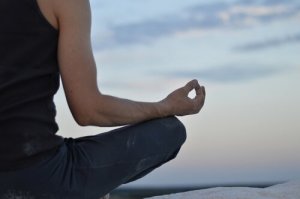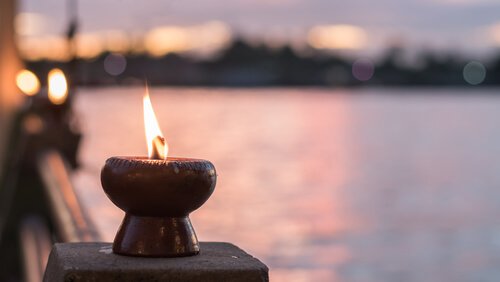The Benefits of a 10-Day Silent Retreat

I could write dozens of articles on the benefits of a 10-day silent retreat. I could spend hours and hours talking about the advantages a spiritual retreat can give you. There are many things I could say… but I’ll only say a few. I’ll only tell you the benefits that I can share with you because most of them are personal and individual. They’re so profound and indescribable, that no matter how many words I write here, they’re still impossible to convey.
When I finished my first 7-day retreat two years ago, the first thing I wanted to do was talk about it. At that moment, I realized that not everyone is prepared to understand what a transformative experience it can be. Since then, I don’t talk much about it unless somebody asks me.
In fact, when I returned from my last retreat, one of the first things somebody said to me was, “Ten days without talking to anyone and without using your cell phone?” “Yes,” I answered. “You’re such a freak,” they responded.
What’s a retreat?
A retreat is basically a break from life. It sounds a bit bleak when you put it that way, so let me explain it better.
In our day to day life, we run into situations that make us angry and have to deal with people that irritate us. We’re also faced with situations that make us sad. In summary, we must constantly face situations that cause discomfort. On the other hand, we’re victims of attachments, which in extreme cases can be classified as addictions.
Hence, a retreat consists of temporarily withdrawing yourself from whatever causes discomfort. As a result, you learn to be by yourself.

The first moments
Since it was my third retreat, I already had some experience. However, the first moments were different. Furthermore, this retreat represented the last thing I had to do to become an instructor in Buddhist meditation. So, naturally, I felt a great responsibility.
Between retreats, life goes on and we continue accumulating experience. When you enter the retreat center, you know that, despite being with other people, you’ll be alone with your mind. You’ll have no cell phone. You’ll have no contact with the outside world.
In our day to day lives, we avoid our most uncomfortable thoughts. We don’t tolerate thinking about what causes us pain. This is why we turn to our cell phones or any other activity that distracts us. In a silent retreat, you’re alone to face those fears, your mind, and your thoughts.
Meditation and thoughts on a silent retreat
Meditation
Since it was a silent retreat at the end of a Tibetan meditation instructor course, we meditated about 5 or 6 times a day to practice. Additionally, we could also meditate individually as many times as we wanted to. We also attended lectures. This was our only auditory stimulus, the teacher’s words a few hours a day. The rest of the day there was silence.
By meditating, you become aware of how many thoughts cross your mind again and again. There are thoughts you believed you had overcome and others that are more recent. Some remain in the back of your mind. You sit with your legs crossed, breathe deeply, and let your thoughts invade your mind. You observe them without judging them. But when you’re done meditating, they come back.
Thoughts
Those thoughts we believed to have under control begin to emerge. They erupt like lava, completely out of control. In our day to day lives, when a tip of a thought emerges, we try to make it disappear by retreating to the Internet.
In a silent retreat, not only does the tip of the iceberg surface, but all of it comes out. Bit by bit, you become aware of its size: it’s huge! You realize that many thoughts are like the iceberg that sunk the Titanic. On the outside, you think they don’t affect you that much. But they’re secretly hurting you and crushing your self-esteem. Congratulations! You’re starting to face your demons!
In a silent retreat, every disturbing thought seems to turn into a fierce dragon.

That’s why, despite the fact that the retreatants may feel blissful, it’s common for anxiety attacks, tremors, sweating, crying, palpitations, and hyperventilation to manifest.
I don’t mean to scare you with this. However, it’s important to know everything that happens when we confront our mind. This shows just how much we hide from ourselves. And when we have to face ourselves, we don’t know where to start.
In some way, we can explain this anxiety as a withdrawal syndrome of everyday life. We’re used to a certain routine and going from one place to the next. But in a silent retreat center, you have a schedule to keep. You can’t access your phone or computer. You can’t leave your room in the middle of the night to get ice cream from the fridge.
What are the benefits of a 10-day silent retreat?
The funny thing is that you don’t begin to feel the benefits of the silent retreat until you return to your daily life. While you’re at the retreat center, you feel peaceful and serene. When you go back to your normal life, you realize that your mind is much calmer and you don’t need to talk. Also, you don’t need as many external stimulations to be happy. You’re content with yourself.
You leave the retreat center and, on your way home, all the noise from your surroundings begins to invade you. Cars, people talking and screaming… You start to become aware of all the excessive noise that surrounds you.
This is why most people are always stressed out, almost on an unconscious level. Those who live alone have an advantage. But when you live with more people at home, one is watching TV, another is on their computer, and another is on their cell phone. Almost all of them are doing something that doesn’t really contribute anything to their lives.
“When we give ourselves the chance to let go of all our tension, the body’s natural capacity to heal itself can begin to work.”
-Thich Nhat Hanh-
When you begin to interact with other people again, you realize that a lot of the conversations we have are purely social. In other words, they fill in gaps and don’t contribute to anything important nor enrich you. After ten intense days dedicated to inner growth, you become aware of the excess information that comes from speaking.
You learn to appreciate the simple things that really give value to your life. When you visit a shopping mall, you see only consumerism and materialism. You open your eyes and realize that, since childhood, you’ve been taught to seek happiness from the outside. Even though happiness is actually found on the inside, we’re not taught how to cultivate it.
The cave, the valley, and the cemetery phases
After a silent retreat, going back to normal is hard. Many become obsessed with talking only about what helps them grow. However, it’s best to achieve a balance. Don’t leave your friends and family aside, but don’t leave aside your meditation practices either.
Rinchen Gyaltsen led the training course in meditation and always spoke of the three phases of the spiritual path:
- Cave phase
- Valley phase
- Cemetery phase
The first phase consists of withdrawing from everything that affects you negatively or creates attachment and to prepare you. It’s a type of mental training.
When we think we’re ready, we go down into the valley to deal with daily life and see how far we’ve evolved.
The cemetery phase may seem to be outdated. In India, rotten bodies used to be placed in cemeteries where they could be seen. Thus, it was said that if a meditator could meditate in a cemetery, he was ready for anything.
Fortunately, today we don’t need to meditate in a cemetery and, if we do, there are no bodies in sight. We can go from the cave phase to the valley phase.
When many people leave the silent retreat, they want everything to remain as calm as it was in the ‘cave’. But this is very difficult and often unrealistic. Every day, hundreds of stimuli bombard us, and we have to face different situations and setbacks.
But it’s also not healthy nor sane to get carried away by the insane and extremely materialistic vortex of the valley phase. The best thing we can do is to know how to interact with our environment while maintaining peace and not leaving our personal practices aside.

Recommendations for a silent retreat
First of all, it’s recommendable to start with a short 2-3-day guided silent retreat. The three silent retreats I’ve gone to (7 days, 3 days, and 10 days) have all been guided. I started directly with a 7-day silent retreat that changed my life. However, for many people, doing such a long silent retreat can be exhausting.
On the other hand, it’s important to know the retreat center you’re going to. In other words, look for references, try to meet people who have gone there, visit their website, and see who the teachers are. This information will make you feel more comfortable and confident.
Another important aspect you should know is that not all retreats are silent. Many have meditation practices but don’t require silence.
It’s also important to know that if you do a silent retreat, you may feel anxious for a few days. This is very common. If you don’t know how to handle your anxiety, it’s best to consult with your teacher or guide. They will give you instructions to help you. Most importantly, remember that you have nothing to fear.
Final comments
Many people tell me that they’d never go on a silent retreat. Nevertheless, I’d definitely recommend the experience. We spend a lot of money on whims and invest a lot of time on empty tasks. Thus, we should also invest some time and money on something so beneficial as personal development.
I could write dozens of articles on the benefits of a 10-day silent retreat. I could spend hours and hours talking about the advantages a spiritual retreat can give you. There are many things I could say… but I’ll only say a few. I’ll only tell you the benefits that I can share with you because most of them are personal and individual. They’re so profound and indescribable, that no matter how many words I write here, they’re still impossible to convey.
When I finished my first 7-day retreat two years ago, the first thing I wanted to do was talk about it. At that moment, I realized that not everyone is prepared to understand what a transformative experience it can be. Since then, I don’t talk much about it unless somebody asks me.
In fact, when I returned from my last retreat, one of the first things somebody said to me was, “Ten days without talking to anyone and without using your cell phone?” “Yes,” I answered. “You’re such a freak,” they responded.
What’s a retreat?
A retreat is basically a break from life. It sounds a bit bleak when you put it that way, so let me explain it better.
In our day to day life, we run into situations that make us angry and have to deal with people that irritate us. We’re also faced with situations that make us sad. In summary, we must constantly face situations that cause discomfort. On the other hand, we’re victims of attachments, which in extreme cases can be classified as addictions.
Hence, a retreat consists of temporarily withdrawing yourself from whatever causes discomfort. As a result, you learn to be by yourself.

The first moments
Since it was my third retreat, I already had some experience. However, the first moments were different. Furthermore, this retreat represented the last thing I had to do to become an instructor in Buddhist meditation. So, naturally, I felt a great responsibility.
Between retreats, life goes on and we continue accumulating experience. When you enter the retreat center, you know that, despite being with other people, you’ll be alone with your mind. You’ll have no cell phone. You’ll have no contact with the outside world.
In our day to day lives, we avoid our most uncomfortable thoughts. We don’t tolerate thinking about what causes us pain. This is why we turn to our cell phones or any other activity that distracts us. In a silent retreat, you’re alone to face those fears, your mind, and your thoughts.
Meditation and thoughts on a silent retreat
Meditation
Since it was a silent retreat at the end of a Tibetan meditation instructor course, we meditated about 5 or 6 times a day to practice. Additionally, we could also meditate individually as many times as we wanted to. We also attended lectures. This was our only auditory stimulus, the teacher’s words a few hours a day. The rest of the day there was silence.
By meditating, you become aware of how many thoughts cross your mind again and again. There are thoughts you believed you had overcome and others that are more recent. Some remain in the back of your mind. You sit with your legs crossed, breathe deeply, and let your thoughts invade your mind. You observe them without judging them. But when you’re done meditating, they come back.
Thoughts
Those thoughts we believed to have under control begin to emerge. They erupt like lava, completely out of control. In our day to day lives, when a tip of a thought emerges, we try to make it disappear by retreating to the Internet.
In a silent retreat, not only does the tip of the iceberg surface, but all of it comes out. Bit by bit, you become aware of its size: it’s huge! You realize that many thoughts are like the iceberg that sunk the Titanic. On the outside, you think they don’t affect you that much. But they’re secretly hurting you and crushing your self-esteem. Congratulations! You’re starting to face your demons!
In a silent retreat, every disturbing thought seems to turn into a fierce dragon.

That’s why, despite the fact that the retreatants may feel blissful, it’s common for anxiety attacks, tremors, sweating, crying, palpitations, and hyperventilation to manifest.
I don’t mean to scare you with this. However, it’s important to know everything that happens when we confront our mind. This shows just how much we hide from ourselves. And when we have to face ourselves, we don’t know where to start.
In some way, we can explain this anxiety as a withdrawal syndrome of everyday life. We’re used to a certain routine and going from one place to the next. But in a silent retreat center, you have a schedule to keep. You can’t access your phone or computer. You can’t leave your room in the middle of the night to get ice cream from the fridge.
What are the benefits of a 10-day silent retreat?
The funny thing is that you don’t begin to feel the benefits of the silent retreat until you return to your daily life. While you’re at the retreat center, you feel peaceful and serene. When you go back to your normal life, you realize that your mind is much calmer and you don’t need to talk. Also, you don’t need as many external stimulations to be happy. You’re content with yourself.
You leave the retreat center and, on your way home, all the noise from your surroundings begins to invade you. Cars, people talking and screaming… You start to become aware of all the excessive noise that surrounds you.
This is why most people are always stressed out, almost on an unconscious level. Those who live alone have an advantage. But when you live with more people at home, one is watching TV, another is on their computer, and another is on their cell phone. Almost all of them are doing something that doesn’t really contribute anything to their lives.
“When we give ourselves the chance to let go of all our tension, the body’s natural capacity to heal itself can begin to work.”
-Thich Nhat Hanh-
When you begin to interact with other people again, you realize that a lot of the conversations we have are purely social. In other words, they fill in gaps and don’t contribute to anything important nor enrich you. After ten intense days dedicated to inner growth, you become aware of the excess information that comes from speaking.
You learn to appreciate the simple things that really give value to your life. When you visit a shopping mall, you see only consumerism and materialism. You open your eyes and realize that, since childhood, you’ve been taught to seek happiness from the outside. Even though happiness is actually found on the inside, we’re not taught how to cultivate it.
The cave, the valley, and the cemetery phases
After a silent retreat, going back to normal is hard. Many become obsessed with talking only about what helps them grow. However, it’s best to achieve a balance. Don’t leave your friends and family aside, but don’t leave aside your meditation practices either.
Rinchen Gyaltsen led the training course in meditation and always spoke of the three phases of the spiritual path:
- Cave phase
- Valley phase
- Cemetery phase
The first phase consists of withdrawing from everything that affects you negatively or creates attachment and to prepare you. It’s a type of mental training.
When we think we’re ready, we go down into the valley to deal with daily life and see how far we’ve evolved.
The cemetery phase may seem to be outdated. In India, rotten bodies used to be placed in cemeteries where they could be seen. Thus, it was said that if a meditator could meditate in a cemetery, he was ready for anything.
Fortunately, today we don’t need to meditate in a cemetery and, if we do, there are no bodies in sight. We can go from the cave phase to the valley phase.
When many people leave the silent retreat, they want everything to remain as calm as it was in the ‘cave’. But this is very difficult and often unrealistic. Every day, hundreds of stimuli bombard us, and we have to face different situations and setbacks.
But it’s also not healthy nor sane to get carried away by the insane and extremely materialistic vortex of the valley phase. The best thing we can do is to know how to interact with our environment while maintaining peace and not leaving our personal practices aside.

Recommendations for a silent retreat
First of all, it’s recommendable to start with a short 2-3-day guided silent retreat. The three silent retreats I’ve gone to (7 days, 3 days, and 10 days) have all been guided. I started directly with a 7-day silent retreat that changed my life. However, for many people, doing such a long silent retreat can be exhausting.
On the other hand, it’s important to know the retreat center you’re going to. In other words, look for references, try to meet people who have gone there, visit their website, and see who the teachers are. This information will make you feel more comfortable and confident.
Another important aspect you should know is that not all retreats are silent. Many have meditation practices but don’t require silence.
It’s also important to know that if you do a silent retreat, you may feel anxious for a few days. This is very common. If you don’t know how to handle your anxiety, it’s best to consult with your teacher or guide. They will give you instructions to help you. Most importantly, remember that you have nothing to fear.
Final comments
Many people tell me that they’d never go on a silent retreat. Nevertheless, I’d definitely recommend the experience. We spend a lot of money on whims and invest a lot of time on empty tasks. Thus, we should also invest some time and money on something so beneficial as personal development.
This text is provided for informational purposes only and does not replace consultation with a professional. If in doubt, consult your specialist.







